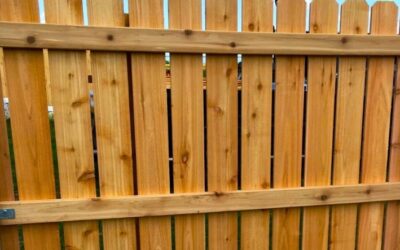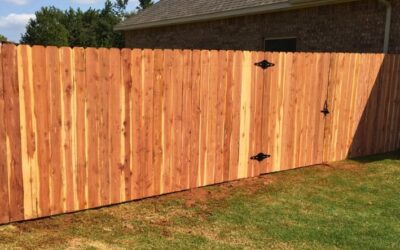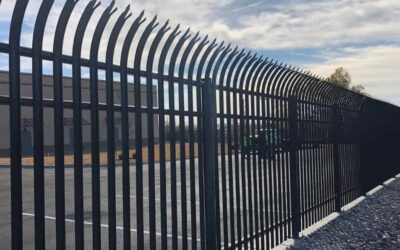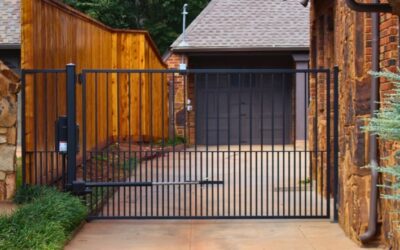How to Measure and Plan for a New Fence: A Complete Guide
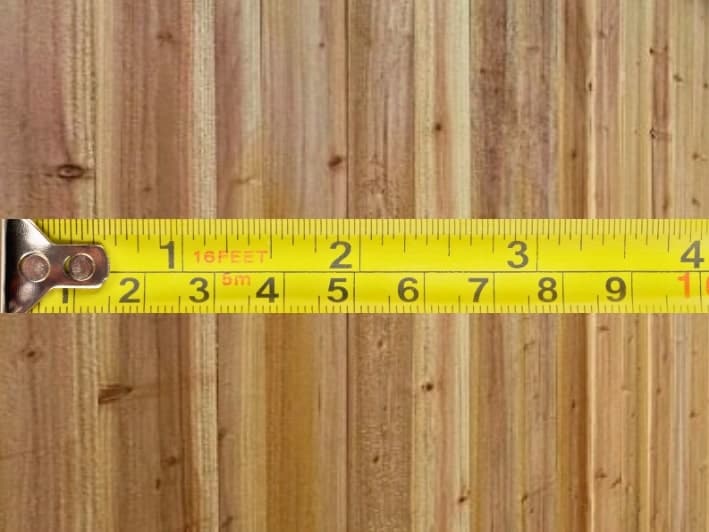
Home » Fence Blog »
Planning and measuring for a new fence is a crucial first step before installing a residential fence. Whether you’re enhancing your home’s curb appeal, adding privacy, or securing your property, accurate measurements and effective planning will save time, reduce costs, and ensure the longevity of your fence.
At Fence OKC, we understand the importance of a smooth installation process and are here to guide you through it.
In this step-by-step guide, we’ll cover everything you need to know about measuring and planning for a new fence, ensuring you’re fully prepared before breaking ground.
Instant fence quote
Draw your fence online and get your price instantly.
Why Planning for a New Fence is Important
Building a fence is about more than aesthetics. It’s about functionality, security, and property value. Proper planning ensures you understand your property boundaries, local regulations, and material needs.
Without this planning phase, you could encounter setbacks like zoning violations or materials shortages, which can derail your project.
When you take the time to plan, you can expect:
- Accurate material estimation
- Compliance with local regulations
- Better budget control
- Efficient installation process
Before we measure, it’s crucial to define your objectives and decide on the type of fence that suits your needs.
Choosing the Right Fence for Your Property
The first step in planning your fence project is deciding what type best meets your needs.
Fences come in various materials and styles, each serving a different purpose. Your options may include:
- Wood Fences: Ideal for privacy and a natural look.
- Vinyl Fences: Low maintenance and durable.
- Chain-Link Fences: Great for security and affordability.
- Ornamental Iron Fence: Elegant and strong, offering security and aesthetic appeal.
By choosing the right fence material, you’ll enhance your property and increase its functionality. For example, a privacy fence might be best for homeowners who want solitude, while a decorative fence could improve the aesthetics of a garden.
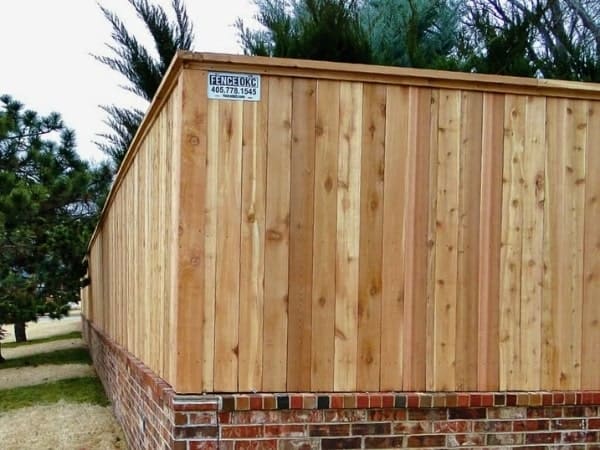
Preparing for the Measurement Process
Once you’ve decided on the type of fence, it’s time to start measuring. This step is crucial, as incorrect measurements can lead to excess costs or material shortages.
Before grabbing a measuring tape, ensure you have a clear plan by considering the following:
- Zoning Laws and Local Regulations: Ensure your fence complies with local building codes. Some areas have specific height restrictions or require a fence installation permit.
- Property Boundaries: Know where your property lines lie. Installing a fence beyond your property could result in legal disputes with neighbors.
- Neighboring Properties: If you share a boundary with a neighbor, it’s courteous (and sometimes legally required) to discuss your fence plans with them.
Tools You’ll Need to Measure and Plan for Your New Fence
Before measuring, gather the necessary tools to ensure accuracy and efficiency.
Here’s a quick checklist to get you started:
- Measuring tape (100 feet or longer)
- Measuring wheel (optional for larger properties)
- Marking spray or stakes to outline post locations
- String or chalk line to mark straight lines
- Graph paper or an online mapping tool to sketch your layout
- Pen or pencil for taking notes and marking measurements
- Assistant (optional but helpful for longer measurements)
These tools will help you measure your backyard accurately, mark key points, and ensure a smooth installation process for your new fence.
Fence OKC
Oklahoma’s modern fence company.
How to Measure for a New Fence
Accurate measurements are the foundation of a successful fence project. Follow these steps to ensure that your measurements are precise:
Step 1: Determine the Total Length of the Fence
Use a measuring tape or surveyor’s wheel to measure the perimeter of the area you plan to enclose. Walk along the planned fence line and note any slopes, curves, or obstructions. For more accuracy, measure twice to ensure you get the same results each time.
- Tip: Sketch the perimeter on paper or use an online tool to create a digital layout. This will help visualize the space and make the planning process more manageable.
Step 2: Mark the Location of Fence Posts
Fence posts are essential to the structure of your fence. They provide support and keep the panels in place. Most standard fences have posts spaced 6 to 8 feet apart, but this can vary depending on the fence type. Use stakes or marking spray to indicate where each post will go.
- Pro Tip: Ensure fence posts are placed at equal distances to maintain symmetry and avoid material wastage.
Step 3: Account for Gates and Access Points
You’ll likely want one or more gates to access your yard. Measure the width of these gates and plan their placement carefully. A standard gate width is about 36 to 48 inches, but larger gates may be needed for vehicle access.
- Reminder: Include extra posts for gates, as they require additional support.
Step 4: Consider Uneven Ground
If your yard has hills or slopes, you must adjust your measurements to account for them. You can either follow the contour of the land (racked fence) or step the fence down in sections (stepped fence).
- Tip: Measure the incline carefully to determine how much adjustment your fence will need.
Step 5: Double-Check Your Measurements
Once you’ve measured the perimeter and gate locations and considered any changes in terrain, double-check your measurements. Spending extra time here is better than encountering problems during installation.
Planning for Fence Materials
Now that you’ve got your measurements, it’s time to figure out how much material you’ll need. Start by calculating the number of posts, panels, and other hardware required for the project.
- Fence Panels: The total linear footage of the fence divided by the width of each panel will give you the number of panels needed.
- Fence Posts: Divide the total length of your fence by the standard distance between posts (typically 6 or 8 feet).
- Gates: Include the necessary hardware for your gates, like hinges and latches.
Material Choices Based on Functionality and Budget
Your material choice should align with your primary objective for building the fence. If privacy is a priority, consider wood or vinyl panels that fully block visibility. On the other hand, a metal or chain-link fence might be more appropriate for securing pets or marking property lines at a lower cost.
Don’t forget to calculate the cost of hardware such as nails, screws, and post-hole concrete. These small elements can add up quickly, so it’s essential to have an accurate estimate.
Planning for Installation
With your materials and measurements ready, it’s time to consider the installation phase. Installing a fence requires careful coordination, especially when digging post holes and setting the fence panels.
Call Before You Dig
Before starting any fence installation in Oklahoma, it’s essential to call OKIE 811.
This free service helps locate underground utilities such as gas, water, and electrical lines to prevent dangerous accidents or costly damage. By calling OKIE 811 at least two business days before digging, you’ll ensure the utility lines are marked, keeping your project safe and compliant with local laws.
Never dig without making the call—it’s a quick step in protecting your property and safety. (Dial 811 from any phone in Oklahoma.)
Hiring a Professional vs. DIY Installation
Many homeowners install fences themselves to save on labor costs, but this can be time-consuming and physically demanding.
Hiring professionals like Fence OKC ensures the job is done right the first time, minimizing future repairs and extending the life of your fence.
- DIY Installation: Best for those with experience in outdoor construction projects.
- Professional Installation: Ideal if you want a stress-free process with high-quality results.
Prepping the Area for Installation
Before installation, clear the area of any obstacles, such as rocks, debris, or plants. Make sure the ground is level where the posts will go. Also, mark underground utilities so you don’t accidentally dig into them.
We Can Help!
Estimates are always free.
Use Fence OKC’s Instant Online Fence Quote
Wondering, “How much fencing do I need?” is a common question when planning a new fence. While walking your yard and measuring by hand is one option, there’s a quicker and more accurate way to get answers. With Fence OKC’s Instant Online Fence Quote, you can easily estimate your fencing needs and explore various styles, materials, and features—all within seconds.
Our user-friendly tool allows you to:
- Map out your fence area
- Choose gate options
- Compare fence types
- Account for yard terrain
Fence installation has never been so easy. Plot the location of your fence (there’s no need for perfection) and customize the fence and gate options. Within seconds, you’ll get an accurate quote for your project.
For additional assistance, check out our guide or connect with one of our fence experts. With our four-step quote tool, you’ll be well on your way to your new fence in no time!
Fence Maintenance Considerations
Proper maintenance will keep the fence looking great and functioning well for years after it is installed. Wood fences require regular staining or painting, while vinyl and metal fences only need occasional cleaning.
- Wood Fences: Apply sealants every few years to prevent weathering.
- Vinyl Fences: Clean with soap and water to remove dirt and mildew.
- Metal Fences: Inspect for rust and apply rust-resistant paint as needed.
Common Mistakes to Avoid When Planning for a Fence
- Inaccurate Measurements: Always double-check your figures to avoid costly mistakes.
- Ignoring Local Zoning Laws: Failure to follow local regulations can result in fines or the need to tear down your fence.
- Poor Material Choices: Choose durable materials suited to your climate.
FAQs
The most frequently asked questions about measuring your backyard fence.
How do I know where my property lines are?
You can obtain a property survey from your local county records office or hire a surveyor for precise measurements.
How much space should be between fence posts?
Typically, fence posts are spaced 6 to 8 feet apart, depending on the type of fence and terrain.
What’s the best fence for a sloped yard?
Racked fences follow the yard’s slope, while stepped fences are installed in sections that “step down” the hill.
Do I need a permit to install a fence?
Many localities require a permit for fence installation, especially for taller fences. Check with your local building department before starting your project.
Can I install a fence myself?
Yes, but it requires significant effort, tools, and expertise. Hiring professionals ensures accuracy and durability.
How long does fence installation take?
A professional crew typically takes 1 to 3 days to install a standard residential fence, depending on the size and complexity of the project.
Conclusion: How to Measure and Plan for a New Fence
Measuring and planning for a new fence are essential to successful installation. By taking the time to accurately measure, choose the right materials, and follow local regulations, you can avoid many pitfalls associated with fence building. Whether installing the fence yourself or hiring a professional like Fence OKC, proper planning will save you time, money, and headaches in the long run.
Let's Have a Conversation
Church Fence Installation in OKC
Oklahoma Church Fence Installation In Oklahoma City (OKC), where church communities flourish and buildings serve as sanctuaries, fellowship centers, and community hubs, ensuring safety and a welcoming presence is paramount. Church fence installation...
Which Fence is Best for Oklahoma High Winds?
What Type of Fence Works Best in Oklahoma's High Winds? Strong, persistent winds are a defining characteristic of Oklahoma's weather, often leading to significant fence damage. Whether dealing with gusty storms, fallen debris, or the notorious...
Why Cedar Fences Are Perfect for Oklahoma Properties
Why Cedar Fences Are Ideal for Oklahoma Yards Cedar fences have long been a staple of beautiful and functional outdoor spaces. For homeowners in Oklahoma, where the climate varies dramatically between scorching summers and icy winters, cedar fences...
What Is a High-Security Fence?
An Introduction to High-Security Fencing In today’s world, where safety is a top priority, a high-security fence installation is the perfect solution for protecting properties against unauthorized access and potential threats. Whether for...
5 Benefits of Installing a Chain Link Fence in Oklahoma
5 Advantages of Installing a Chain Link Fence in Oklahoma Chain-link fences are among the most popular and practical solutions for securing property. They offer unique advantages for Oklahoma residents and are tailored to their environment,...
5 Signs It’s Time to Upgrade Your Automatic Gate System
5 Reasons to Update Your Driveway Gate In today’s world, your home or business’s security is only as strong as your entry points. Automatic gate systems play a significant role in enhancing property security, ensuring smooth access, and adding a...
WHAT WE DO
PROFESSIONAL FENCE CONTRACTOR IN OKC
For over a decade, Fence OKC has proudly stood as Oklahoma City’s go-to modern fence company, dedicated to excellence in all aspects of fencing. Whether you’re looking to enhance the security or elevate the aesthetics of your property, our expertise has been shaping neighborhoods and fortifying businesses since 2011.
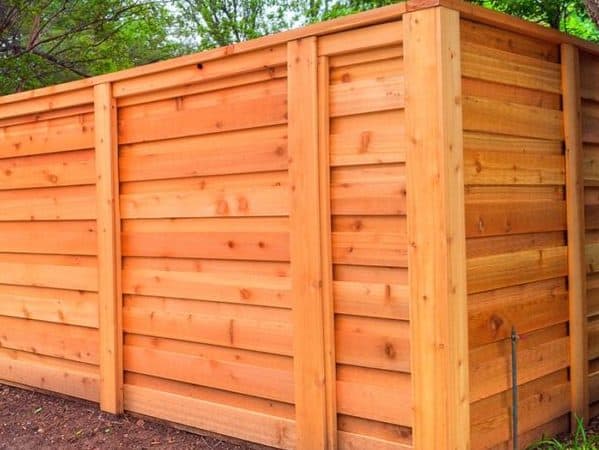

RESIDENTIAL FENCE
We specialize in custom cedar fence installation in Oklahoma, especially wood privacy and picket fencing. We also offer hand-built cedar fences built on-site and by the “stick.”
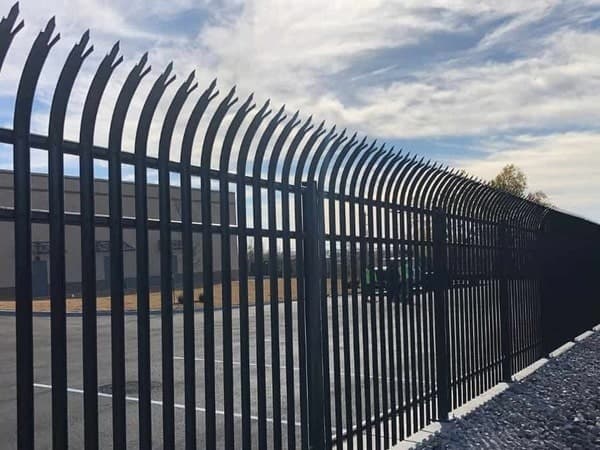

COMMERCIAL FENCING
Fence OKC prides ourselves on professionalism and attention to detail. We can install any kind of commercial fence from high security fence to heavy duty wrought iron fencing.
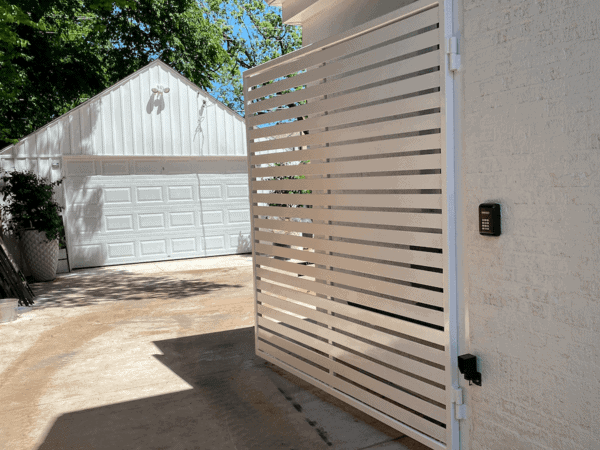

AUTOMATED GATES
Fence OKC is among one of the few licensed providers in Oklahoma for automated gate installations, repairs, and manufacturing, catering to commercial and residential needs.
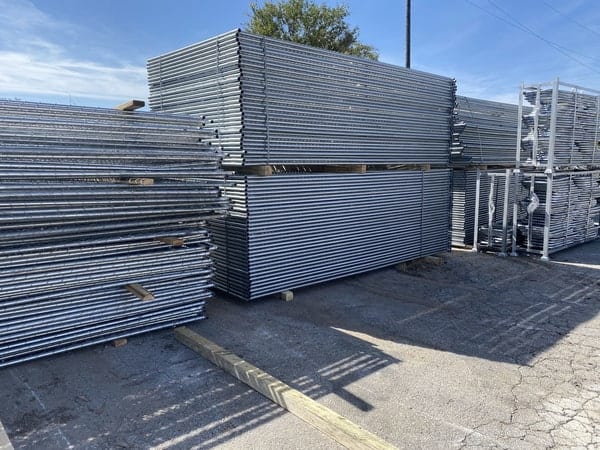

TEMPORARY FENCE PANELS
Temporary chain link fence panels are favored for construction zones, events (both indoor and outdoor), and sports gatherings, especially when installing in-ground posts isn’t feasible.
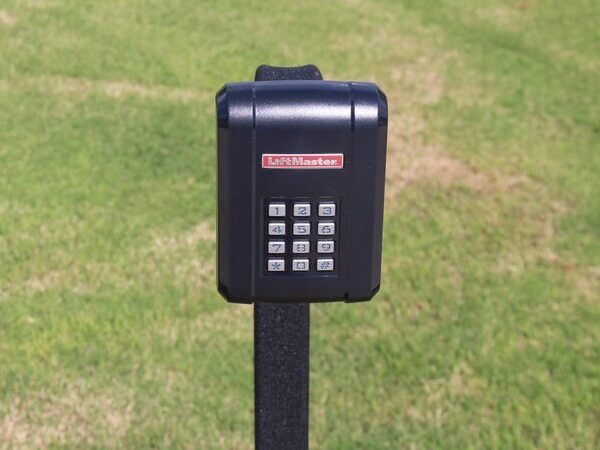

ACCESS CONTROL SYSTEMS
Protect your residential or commercial property with our state-of-the-art gate service and access control systems. Licensed and bonded, we can help with your security concerns.
Need Some Help?
Should you need help or have any inquiries, the team at Fence OKC stands ready to assist. We are dedicated to addressing all your fencing concerns in Oklahoma City, ensuring you choose the ideal fence for your needs.
OKLAHOMA CITY, OKLAHOMA
LOCATION AND SERVICE AREAS
Located in the heart of Oklahoma City, Fence OKC proudly serves a broad spectrum of areas, ensuring every corner of our community benefits from top-tier fencing solutions. We've got you covered whether you're near or a bit further out.


Fence OKC Service Areas
Edmond • Oklahoma City • Norman • El Reno • Moore • Yukon • Mustang • Piedmont • Guthrie • New Castle • Blanchard • Tuttle • Choctaw • Harrah • Nichols Hills • Arcadia • Jones • Newalla • Gallardia • Del City • Tulsa • Noble • Midwest City • Kingfisher • Stillwater • McCloud • Bristow • Sapulpa • Broken Arrow • Sand Springs • Owasso • Enid • Weatherford • Hinton • Elk City • Clinton • Woodward








